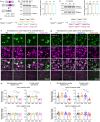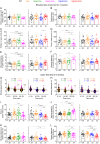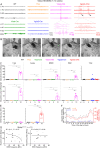GABAergic/Glycinergic and Glutamatergic Neurons Mediate Distinct Neurodevelopmental Phenotypes of STXBP1 Encephalopathy
- PMID: 38360746
- PMCID: PMC10993039
- DOI: 10.1523/JNEUROSCI.1806-23.2024
GABAergic/Glycinergic and Glutamatergic Neurons Mediate Distinct Neurodevelopmental Phenotypes of STXBP1 Encephalopathy
Abstract
An increasing number of pathogenic variants in presynaptic proteins involved in the synaptic vesicle cycle are being discovered in neurodevelopmental disorders. The clinical features of these synaptic vesicle cycle disorders are diverse, but the most prevalent phenotypes include intellectual disability, epilepsy, movement disorders, cerebral visual impairment, and psychiatric symptoms ( Verhage and Sørensen, 2020; Bonnycastle et al., 2021; John et al., 2021; Melland et al., 2021). Among this growing list of synaptic vesicle cycle disorders, the most frequent is STXBP1 encephalopathy caused by de novo heterozygous pathogenic variants in syntaxin-binding protein 1 (STXBP1, also known as MUNC18-1; Verhage and Sørensen, 2020; John et al., 2021). STXBP1 is an essential protein for presynaptic neurotransmitter release. Its haploinsufficiency is the main disease mechanism and impairs both excitatory and inhibitory neurotransmitter release. However, the disease pathogenesis and cellular origins of the broad spectrum of neurological phenotypes are poorly understood. Here we generate cell type-specific Stxbp1 haploinsufficient male and female mice and show that Stxbp1 haploinsufficiency in GABAergic/glycinergic neurons causes developmental delay, epilepsy, and motor, cognitive, and psychiatric deficits, recapitulating majority of the phenotypes observed in the constitutive Stxbp1 haploinsufficient mice and STXBP1 encephalopathy. In contrast, Stxbp1 haploinsufficiency in glutamatergic neurons results in a small subset of cognitive and seizure phenotypes distinct from those caused by Stxbp1 haploinsufficiency in GABAergic/glycinergic neurons. Thus, the contrasting roles of excitatory and inhibitory signaling reveal GABAergic/glycinergic dysfunction as a key disease mechanism of STXBP1 encephalopathy and suggest the possibility to selectively modulate disease phenotypes by targeting specific neurotransmitter systems.
Keywords: epilepsy; excitation; inhibition; intellectual disability; neurobehavior; synapse.
Copyright © 2024 Kim et al.
Figures









References
-
- Asinof SK, Sukoff Rizzo SJ, Buckley AR, Beyer BJ, Letts VA, Frankel WN, Boumil RM (2015) Independent neuronal origin of seizures and behavioral comorbidities in an animal model of a severe childhood genetic epileptic encephalopathy. PLoS Genet 11:e1005347. 10.1371/journal.pgen.1005347 - DOI - PMC - PubMed
Publication types
MeSH terms
Substances
Grants and funding
LinkOut - more resources
Full Text Sources
Medical
Molecular Biology Databases
Research Materials
